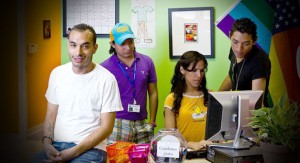Film gives voice to ignored HIV carriers
Less than half a mile walk from the Capitol building in Washington, D.C. is what documentary producer Sheila Johnson calls “the real D.C.,” which is “an underground horror that nobody wants to touch.”

Speak out · HIV-positive Jose Ramirez (left) works to educate his peers and community about the dangers of unsafe sex, yet manages to maintain a comedic outlook on life in Susan Koch’s documentary The Other City. - Photo courtesy of Cabin Films, photo by Jonah Koch
This is the part of Washington, D.C. showcased in The Other City, a moving documentary directed by Susan Koch on the HIV epidemic plaguing our nation’s capital. Washington has the highest HIV rate anywhere in the country, and higher than the capitals of Haiti and Senegal. If 1 percent of the population were diagnosed, it would be considered a severe epidemic by the World Health Organization. The current rate is 3 percent — and it’s rising.
Those are not just numbers, but people, as journalist and screenwriter Jose Vargas reminds the audience early in the film. And that is what the documentary shows us: the “invisible” side of D.C. that isn’t seen on C-SPAN, Fox News or The Real Housewives of D.C., the side that is filled with real people, incredible poverty and extensive suffering.
The Other City follows a handful of characters, all HIV positive, who live in Washington, D.C. Koch says that it was important to her “to show that this disease is touching lots of demographics, and show their shared humanity.” She accomplishes this by following people of different races, ages, genders and sexual orientations, all of whom have inspiring, often heartbreaking stories to tell.
J’mia, a 28-year-old HIV-positive mother of three young children, is one of the characters with whom Koch spends the most time. J’mia is losing her subsidized housing because the D.C. HIV/AIDS Administration lost funding.
She is adamant that her children will not live on the streets, and she goes through the arduous process of applying for new housing. She is ultimately put on a waiting list, whose wait could exceed two years. Although the narrative of J’mia’s housing search might move slowly with little dramatic tension, the audience feels a deep-seeded frustration with the bureaucracy that will let a mother and her three children end up homeless.
“I feel like I’m slipping through the cracks,” she said during the application process.
The most touching footage comes from Joseph’s House, a small hospice for people dying of AIDS where employees create a loving community for those who have come there. A 35-year-old man named Jimmy, who was diagnosed as a teenager, has elected to go to Joseph’s House.
Although Jimmy is unable to speak because of the advanced stage of his disease, Jimmy’s mother and sister speak, to heartrending effect, about what it is like to have a family member dying of AIDS.
Koch says she likes to take a “fly on the wall” approach when filming documentaries, and she captures some wonderfully intimate moments with Jimmy’s family and the Joseph’s House staff.
The young José Ramirez thankfully provides a note of humor to the otherwise emotionally draining film. José is gay, and works to educate young Latinos about practicing safe sex, specifically targeting the gay community. Though it is clear that José is serious about his work, he maintains a joking attitude. José, like many of the people in this documentary, has attempted to make the most of being HIV positive — by helping to protect others. And seeing his ability and eagerness to turn something so destructive into something so productive offers some faith in humanity.
Jose’s openness and frank discussion of sex and sexuality is a reminder of the importance of conversation. He half-jokingly harasses his mother for not talking to him about sex, but the issue of education is an important one.
Koch and Johnson both stress that they want their documentary to be an educational tool for young people, among whom HIV rates are growing. The generation that lived through the AIDS crisis of the 1980s, when medication was not always available, was intensely aware of the presence of the epidemic.
“AIDS was a death sentence,” Koch said, “People looked sick.”
But now, with better medicines, the virus has “disappeared” from sight. People have stopped talking about it, and thus many have stopped doing something about it.
The documentary, however, shows us what an inspiring group of individuals is doing to make a difference.
